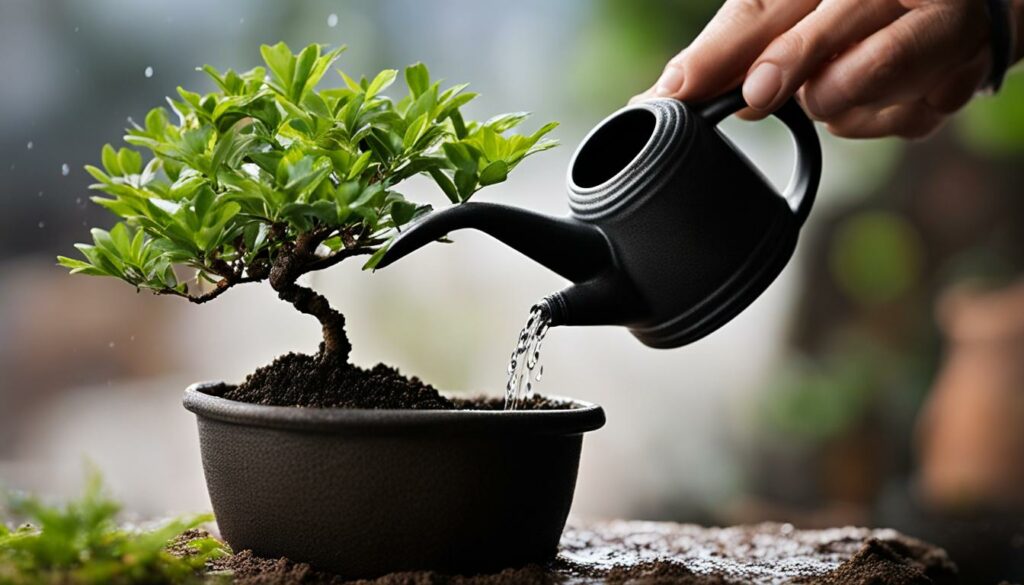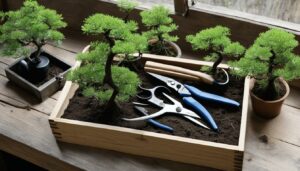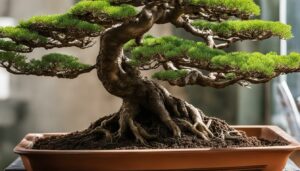Nurturing a bonsai tree requires a gentle touch and a deep understanding of Bonsai hydration, which is paramount to the art of bonsai care. As you embark on this rewarding journey, grasping the various watering techniques is vital to maintaining the necessary moisture levels for your miniature trees to flourish. With this beginner’s guide, you will learn to water your bonsai with the same precision and dedication as a seasoned grower, ensuring your tree’s vitality for years to come.
Key Takeaways
- Understanding moisture balance is crucial for bonsai survival and health.
- Proper watering techniques can significantly enhance a bonsai’s aesthetic appeal.
- Developing a routine is key for consistent and successful bonsai hydration.
- Recognizing the signs of over or under-watering will protect your bonsai from common issues.
- Choosing the right tools and soil mix plays a significant role in effective bonsai watering.
Understanding the Importance of Proper Bonsai Hydration
Embarking on the journey of bonsai care requires an understanding that moisture balance is not merely a routine, it’s an art—a delicate dance of water, soil, and air, pivotal for bonsai tree health. Your bonsai’s health reflects how well this balance is maintained, revealing the symbiotic nature of growth and hydration.
Adequate water intake is the lifeblood of your bonsai, affecting everything from the flexibility of its branches to the vibrancy of its leaves. Neglecting this key aspect opens the door to a plethora of issues, possibly leading to the demise of your miniature tree. But fear not, understanding the ‘whys’ and ‘hows’ of proper hydration will empower you to cultivate a thriving bonsai.
- Preventing Root Rot: Too much water can be just as detrimental as too little. Ensuring proper drainage and moisture balance helps prevent root rot, a silent killer of bonsai trees.
- Combating Dehydration: On the flip side, underwatering leads to dehydration. A well-hydrated bonsai is resilient, with leaves that stand testament to its vigor.
- Enhancing Aesthetic Appeal: Bonsai is an art form, and the health of your tree directly influences its aesthetic appeal. Like a well-nourished canvas, your bonsai becomes a masterpiece with proper care.
Bonsai enthusiasts often say that watering is not just a chore—it’s a moment of connection. When you grasp the right moisture balance, you also touch the essence of life within your bonsai. Each drop of water carries the potential for life or decay, making your role as caretaker one of paramount importance for the preservation and enhancement of your bonsai’s well-being.
Choosing the Best Water to Use for Bonsai Trees
The vitality of your bonsai is profoundly influenced by the water quality used for bonsai watering. Whether drawn from the tap, captured from a rainstorm, or poured from a distilled container, each type of water carries distinct characteristics that can either nurture or challenge the bonsai growth process. Let’s explore how to select the best water to ensure your bonsai flourishes.
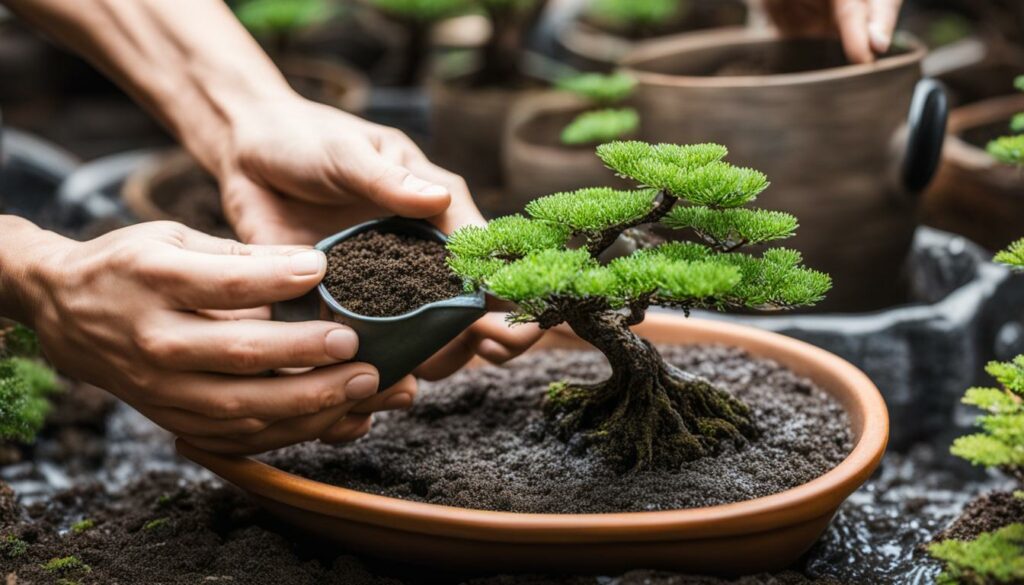
Tap water is the most accessible, but its high mineral content and chemicals like chlorine can affect your bonsai adversely. Rainwater, on the other hand, is often touted as the ideal choice due to its natural softness and balance of pH. However, collecting and storing sufficient quantities can be impractical. Distilled water represents purity, free from chemicals and minerals, but using it exclusively might lead to a deficiency of necessary trace elements.
To ensure you make an informed decision, consider the following table comparing different water types:
| Water Type | Benefits | Drawbacks | Suitability for Bonsai |
|---|---|---|---|
| Tap Water | Readily available, contains some beneficial minerals | Can contain chlorine, fluoride, and may be hard | Use wisely; if hard, consider mixing with rain or distilled water |
| Rainwater | Soft water, neutral pH, free of chlorine | Variable availability, potential for pollutants | Ideal when clean and collected safely; best mixed with tap water |
| Distilled Water | Free from chemicals and minerals | Lacks beneficial minerals needed for growth | Good in combination with other water types to balance mineral content |
You should tailor your bonsai watering practices to complement the natural growth cycle of the tree, and that includes the type of water used. Observe your bonsai carefully after watering with different water kinds to perceive how it reacts to each and adjust accordingly for optimal bonsai health.
Identifying the Perfect Timing for Bonsai Watering
Determining the optimal watering schedule for your bonsai is vital for its survival and flourishment. Unlike other plants, bonsai trees require a careful balance of soil moisture and dry periods, forcing enthusiasts to adopt specific watering techniques. Becoming adept at this combines observation, understanding your tree’s needs, and being mindful of seasonal care variations.
How to Assess Soil Dryness
The first step in bonsai watering is to assess soil moisture accurately. You want the soil to dry out slightly between waterings, but never to the point where the bonsai suffers dehydration. One commonly recommended method is the finger test. Simply insert your finger about an inch into the soil. If the soil feels dry at that depth, it’s time to water. For a more technological approach, consider using a soil moisture meter, which can provide a more precise reading of the moisture levels within the bonsai pot.
Adjusting Watering Schedules with the Seasons
Seasonality greatly influences your bonsai’s thirst. The changing temperatures and weather conditions throughout the year mean that your watering schedule must adapt accordingly. Here’s a general guide to seasonal watering:
| Season | Watering Frequency | Additional Notes |
|---|---|---|
| Spring | Increase gradually as new growth appears | Be observant of rapid growth spurts during this time |
| Summer | Regular watering, may require daily | High temperatures can dry out soil quicker |
| Fall | Gradually decrease frequency | Prepare for dormancy; reduce as temperature drops |
| Winter | Minimal; ensure soil does not freeze | Usually, watering is less frequent during dormancy |
By tuning into your bonsai’s needs, actively assessing soil moisture, and adjusting your watering techniques to accommodate seasonal care needs, you’ll foster a healthy and thriving bonsai. Patience and attentiveness are your greatest tools as you fine-tune this practice over time.
Establishing a Watering Routine for Optimal Bonsai Care
As a bonsai enthusiast, you recognize the intricate dedication required for bonsai maintenance. One of the most essential aspects to master is establishing a reliable watering routine, ensuring consistent moisture levels for your miniature tree. It’s not just about the frequency of watering, but also understanding your bonsai’s unique needs and how they change over time.
Your bonsai’s water requirements are influenced by various factors including the species, pot size, and whether it’s placed indoors or outdoors. These factors determine how quickly the soil dries out and when it’s time for the next watering. Observe your bonsai’s response to watering and adjust your routine as necessary. A consistent routine is the backbone of healthy bonsai care.
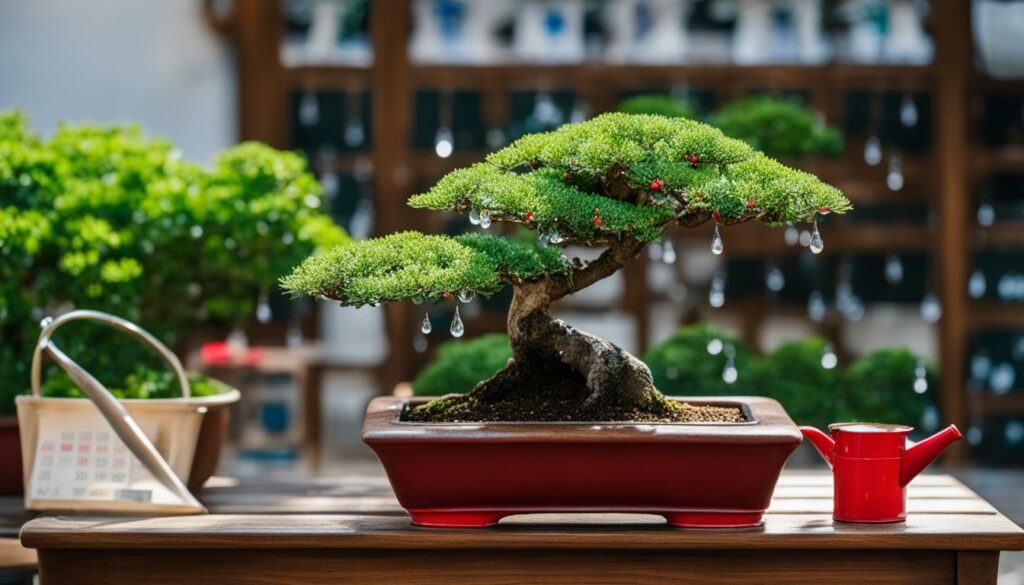
Tracking your bonsai’s watering schedule can be simplified with a basic table that logs factors affecting its hydration needs. Here is an example of what such a table might look like:
| Tree Species | Pot Size | Location | Season | Watering Frequency |
|---|---|---|---|---|
| Juniper Bonsai | 10 inches | Outdoor | Summer | Every other day |
| Ficus Bonsai | 8 inches | Indoor | Winter | Weekly |
| Pine Bonsai | 12 inches | Outdoor | Autumn | Twice a week |
Remember that this table is just a starting point. The ideal watering routine is attained through careful observation and adjustment. Monitor the soil’s dryness level, the leaves’ health, and the overall vigor of your bonsai. Do not be afraid to tailor your routine to the needs of your tree, as every bonsai’s requirements will differ.
In conclusion, developing a personalized watering schedule is vital to nurturing a flourishing bonsai. Keep a close eye on your bonsai and remember, consistency is the key to achieving optimal bonsai care.
Mastering Various Watering Techniques
Understanding different watering techniques is fundamental in bonsai care. These methods not only provide the moisture your plants need but also cater to the specific requirements of each bonsai species. Learning these techniques ensures your bonsai receives the right amount of water without causing harm due to over or under-watering.
Learning the Submersion Technique
Submersion, often referred to as the soak-and-drain method, is ideal for ensuring the roots and soil are thoroughly moistened. To practice submersion:
- Fill a basin with water to just below the rim of your bonsai pot.
- Gently place the bonsai pot in the water.
- Wait until air bubbles cease to rise, indicating that the soil is saturated.
- Lift the bonsai out and allow it to drain completely before returning it to its usual location.
Applying Top Watering Practices
Top watering is the traditional approach where you water the plant from above, simulating natural rainfall. This method gives you more control over the amount of water delivered and is less time-consuming than submersion. Follow these steps:
- Use a watering can with a fine nozzle to gently apply water until it runs out of the drainage holes.
- Avoid disturbing the soil; a gentle approach will prevent erosion.
- Repeat the process after a few minutes to ensure deep watering, promoting healthy root growth.
Setting Up Drip Irrigation for Consistent Moisture
Drip irrigation is a smart solution for maintaining consistent moisture levels, especially if you have multiple bonsai trees. This system delivers water directly to the base of each plant at a controlled rate. Setting up a drip irrigation system might include:
- Installing a network of tubing and emitters that target individual bonsai containers.
- Adjusting the flow to meet the unique hydration needs of each bonsai tree.
- Using a timer to automate watering sessions, which is especially helpful during busy schedules or vacation periods.
Remember, each bonsai is unique and may require a blend of these watering techniques. Monitoring your plants’ response to different methods is key to developing an optimal watering regimen that promotes healthy bonsai growth. Equip yourself with knowledge and the art of observation, and your bonsai will thrive under your dedicated care.
Recognizing Signs of Improper Moisture Levels
Keeping your bonsai healthy requires an understanding of the delicate balance of bonsai hydration. Whether you’re a seasoned bonsai enthusiast or a newcomer to this age-old art, recognizing the signs of overwatering and under watering symptoms is critical to the vitality of your miniature tree.
Bonsai hydration is not just about the amount of water given, but also about observing the response of the tree to watering habits. Take note of how your bonsai reacts after watering and adjust your approach accordingly. The key to success lies in interpreting these signs correctly:
- Overwatering: Yellowing leaves, swollen or brown roots, and a soggy substrate may signal that you’re giving your bonsai more water than it requires.
- Under Watering: Dry leaves, a brittle trunk, and consistently dry soil suggest that your bonsai is not receiving enough water to thrive.
If you suspect that your bonsai’s watering schedule is off balance, it’s time to take a closer look. The following table presents a clear comparison between the symptoms of overwatering and under watering, providing an easy reference to help you recalibrate your watering technique.
| Condition | Signs of Overwatering | Signs of Under Watering |
|---|---|---|
| Leaves | Yellowing, drop off | Brittle, curled edges |
| Soil | Consistently wet, moss or algae growth | Hard, dry to the touch |
| Roots | Soggy, dark, and possibly rotten | Dry, light in color, brittle |
| Trunk | Soft and mushy texture | Hard, no flexibility |
| Growth | Stunted, prone to disease | Slowed, leaves may be smaller than usual |
Correcting your bonsai’s moisture level is a game of patience and observation. If overwatering is the issue, allow the soil to dry out a bit before applying more water. For trees that are under watered, slowly reintroduce moisture to avoid shock and closely monitor the reaction.
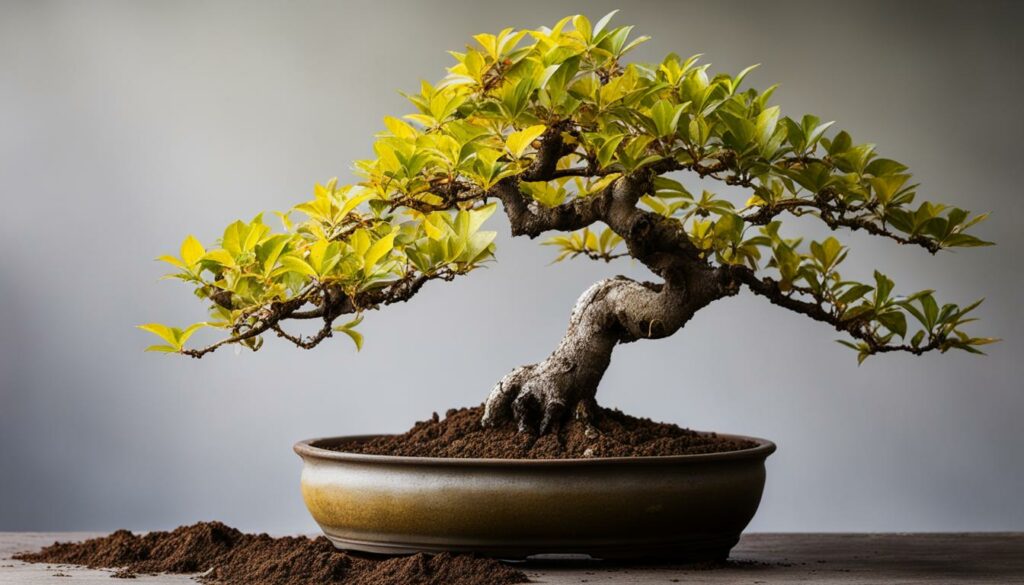
In time, you will develop an intuition for your bonsai’s needs, making adjustments to the frequency and quantity of water provided. Remember, a balanced approach to bonsai hydration will create a strong foundation for your tree to flourish beautifully for years to come.
Essential Equipment for Precise Bonsai Hydration
As you delve deeper into bonsai care, the precision of hydration becomes more apparent and critical for the health of your miniature tree. The following equipment can help in achieving just the right level of moisture for your bonsai.
Choosing the Right Watering Can for Your Bonsai
The choice of a watering can is not merely aesthetic; it can make a tangible difference in how water is delivered to your bonsai. Look for a can with a long spout to ensure a gentle and even distribution of water, replicating a soft rain. Durability and comfort should also factor into your decision.
Utilizing Moisture Meters for Accuracy
Guesswork can be detrimental when it comes to bonsai hydration. Moisture meters are invaluable for providing precise readings of soil moisture content, guiding you on when your bonsai needs water. This can prevent both under-watering and overwatering, safeguarding your bonsai’s health.
Incorporating Sprayers and Misters into Bonsai Care
For maintaining humidity and ensuring your bonsai leaves are free from dust, incorporate the use of sprayers and misters. They are essential in keeping your bonsai fresh and aiding in simulating the natural moisture of a bonsai’s ideal environment.
Bonsai Tools Comparison
| Tool Type | Usage | Benefits |
|---|---|---|
| Watering Can | General watering | Controlled, even flow; mimics rainfall |
| Moisture Meter | Measuring soil moisture | Accurate watering schedules; prevents over/under-watering |
| Sprayers and Misters | Leaf and air moisture | Increases humidity; keeps leaves clean and healthy |
Each of these bonsai tools plays a unique role in maintaining the delicate moisture balance necessary for a thriving bonsai. Invest time in learning to use them effectively, and your bonsai will thank you with vigorous growth and beauty.
Understanding the Role of Soil in Bonsai Moisture Retention
The success of your bonsai’s growth significantly depends on the soil mix and its moisture retention capabilities. Achieving an optimal balance of water intake and drainage is crucial, and this is where the magic of bonsai substrate comes into play. In bonsai cultivation, each soil component serves a purpose, whether it’s water retention, nutrient holding, or providing proper aeration to the roots.
There are various soil mixtures available that can cater to the specific needs of your bonsai. Akadama, for instance, is a traditional Japanese bonsai soil that offers excellent moisture retention while allowing for proper drainage. Complemented by other aggregates like pumice, lava rock, and organic materials, it creates a soil structure conducive to optimal water and nutrient uptake.
- Akadama: Retains water and nutrients, breaks down slowly for root health.
- Pumice: Increases aeration, provides a stable structure for roots.
- Lava Rock: Offers excellent drainage, preventing waterlogging.
- Organic Compost: Enriches the soil with nutrients, retains moisture.
Understanding the right proportions of these components is key to developing a bonsai substrate that will sustain your tree’s life and beauty. It’s not just about watering; it’s about creating an environment where water is used and regulated effectively. Adjusting your soil mix according to your specific bonsai species and climate can lead to more predictable moisture retention, ensuring the tree’s health and vigor.
By working with these different elements, you can create a mix that truly complements the unique watering needs of your bonsai, optimizing both moisture retention and drainage.
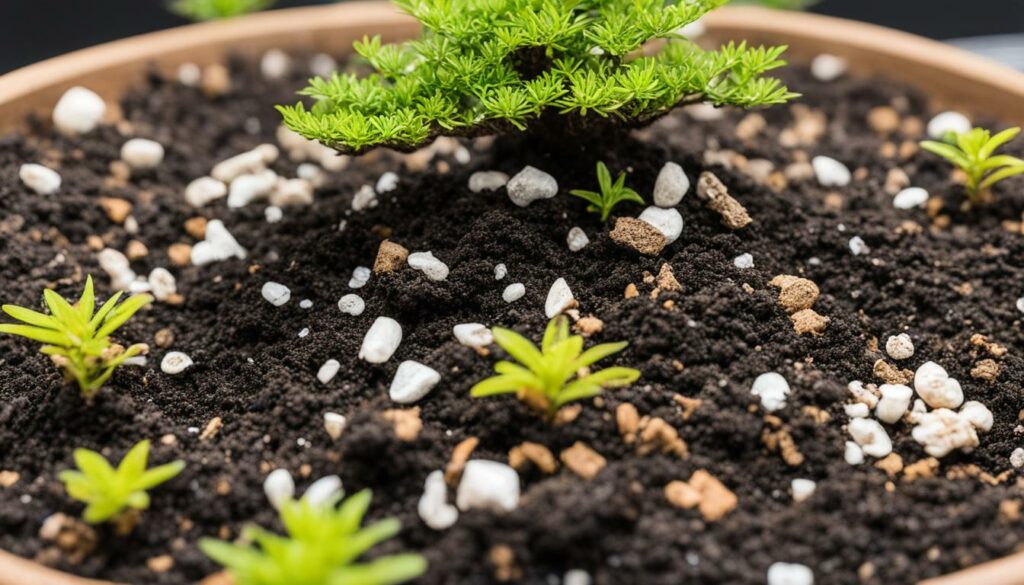
To tailor your bonsai’s soil for optimum moisture retention, consider experimenting with different compositions. Each bonsai tree might react differently, even to slight changes in the soil mix, indicating the necessity of a personalized approach to bonsai care.
Bear in mind that changing your soil mix isn’t a one-time task but an ongoing process. As your bonsai grows and its needs evolve, so too must your approach to its substrate. The end goal is a harmonious balance where the soil’s consistency supports a healthy cycle of hydration and nutrient supply.
How Pot Selection Impacts Bonsai Watering
When tending to your bonsai, the significance of the pot in which it resides cannot be overstated. Not a mere vessel, a bonsai pot is a critical component that affects watering frequency, drainage, and the overall vitality of your precious tree.
Different Pots and Their Drainage Properties
The choice of a bonsai pot directly impacts how water drains after irrigation – a key factor in preventing root rot. Pots crafted from porous materials such as unglazed clay provide excellent aeration and moisture evaporation, leading to more frequent needs for watering. Conversely, glazed pots, while retaining moisture longer, require a delicate balance to avoid over-saturation of the soil.
| Material | Drainage Efficiency | Typical Watering Frequency |
|---|---|---|
| Unglazed Clay | High | More Frequent |
| Glazed Ceramic | Moderate | Less Frequent |
| Plastic | Low | Varies |
| Concrete | Moderate to High | Dependent on Weather |
| Wood | Low to Moderate | Varies, Tends Toward Frequent |
The Relationship Between Repotting and Watering Frequency
Repotting is not just about giving your bonsai a new home; it’s an essential practice that can reset the watering clock of your bonsai. Refreshed soil offers restored drainage and aeration capabilities, which typically means adjusting watering frequency afterward. Align your watering schedule with your bonsai’s evolving needs to foster a harmonious growth environment.
- Post-repotting, monitor your bonsai closely for changes in soil moisture levels.
- Be mindful that new pots can affect the water retention characteristics of the soil.
- Allow your bonsai to adapt to its new container, gradually establishing a consistent watering routine.
The Impact of Environment and Climate on Bonsai Hydration
As an enthusiast, recognizing environmental factors that sway your bonsai watering needs is key. Not only does this include the immediate environment of your living space, but climate influence plays an even larger role. Balancing these conditions is essential to the welfare of your miniature tree. Adapting your bonsai watering regimen to align with the ever-fluctuating environment ensures that your bonsai prospers.
For instance, during periods of high humidity, your bonsai will hold moisture in its soil longer, decreasing the demand for frequent watering. In contrast, dry, hot weather attributable to summer months escalates evaporation rates, calling for a more vigilant watering schedule. Light is another pivotal element; bonsai trees in direct sunlight require more water compared to those in a shade.
Let’s break it down further with a concise table illustrating how various environmental parameters affect your bonsai’s hydration requirements. This way, you can anticipate changes and prevent the stress of over- or under-watering.
| Environmental Factor | Impact on Bonsai Watering | Adaptation Strategy |
|---|---|---|
| High Humidity | Decreases soil dry-out rate | Extend intervals between watering |
| Low Humidity | Increases soil dry-out rate | Monitor more frequently, water as needed |
| High Temperature | Increases evaporation | Water more frequently, particularly on hot days |
| Cool Temperature | Slows down evaporation | Reduce watering frequency |
| Intense Light | Increases water uptake and transpiration | Ensure soil remains moist, avoid drying out |
| Low Light | Decreases water uptake and transpiration | Be cautious not to overwater |
Remember, though, these are general guidelines—your bonsai is unique and may respond to environmental changes in its own way. Maintaining a keen eye on your plant and being responsive to its needs will lead to a flourishing and robust bonsai.
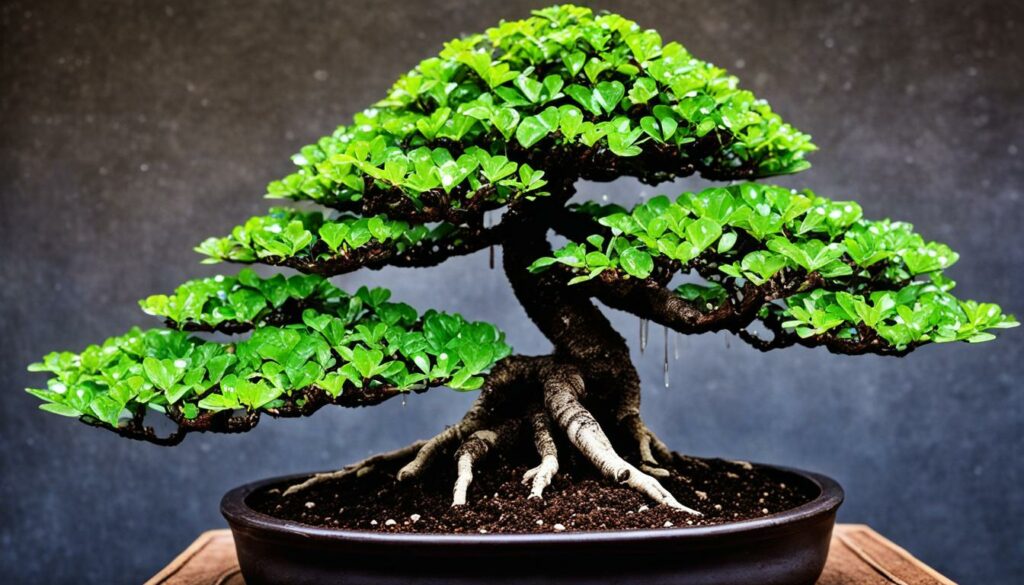
Fertilization: Enhancing Bonsai Health and Watering Efficiency
While bonsai enthusiasts often focus on the intricacies of watering, bonsai fertilization is equally critical to the health and vitality of these miniature trees. Understanding how to properly fertilize can significantly boost nutrient uptake and improve watering efficiency, yielding a thriving bonsai with lush foliage and robust growth.
To truly integrate fertilization into your bonsai care routine, it’s important to first grasp the connection between nutrients and water. Fertilizers provide essential elements that improve a plant’s ability to absorb water and nutrients. This strengthened nutrient uptake allows for more efficient use of the water you provide, reducing waste and ensuring your bonsai gets the nourishment it needs.
- Choose a bonsai-specific fertilizer to cater to the unique needs of your tree.
- Apply fertilizer during the growing season when your bonsai’s nutrient intake is at its peak.
- Be mindful of over-fertilization, which can damage the roots and negatively impact water absorption.
By enhancing the soil with the right balance of fertilizers, you can create a nurturing environment for your bonsai that promotes healthier growth and more efficient use of every drop of water. Remember that bonsai fertilization schedules will vary depending on the species and the current stage of the plant’s life cycle.
Moreover, incorporating a well-timed fertilization plan can diminish the risks of environmental stress, making your bonsai more resilient and better-equipped to utilize water and nutrients even under less than ideal conditions.
Proper bonsai fertilization, combined with judicious watering practices, form the humble roots of magnificent bonsai artistry.
Exploring Advanced Bonsai Watering Strategies for Long-Term Care
As you delve deeper into the world of bonsai, advanced watering strategies become crucial for long-term bonsai care. To truly refine your watering technique, expert tips can elevate your bonsai’s health and vitality. It’s not just about when and how much to water, but about understanding your bonsai’s unique needs and responding to them with precision and care.
Employing a cycle of soaking and drying can greatly benefit your bonsai. This technique mimics the natural conditions where a period of rainfall is followed by sunshine and drying. It allows the roots to breathe and prevents the onset of root rot. On the other hand, gradual watering ensures that water penetrates evenly throughout the soil, reaching all the roots without causing erosion or nutrient runoff.
The balance of nutrients and water is another aspect of advanced care. In well-fertilized soil, bonsai trees can make more efficient use of water. Small, regular doses of fertilizer can keep your bonsai’s root system healthy and water uptake optimal. Here’s a guide to help you understand how these variables interplay:
| Watering Strategy | Benefits | Considerations |
|---|---|---|
| Soak-and-Dry Cycle | Promotes root health, Prevents disease | Requires close monitoring of soil moisture |
| Gradual Watering | Even water distribution, Minimal nutrient loss | May take more time than other methods |
| Integrated Fertilization | Enhanced water efficiency, Supports vigorous growth | Fertilizer type and quantity must be carefully selected |
To further your expertise in long-term bonsai care, consider not only the above techniques but also the use of technology and automation. Moisture sensors and automated irrigation systems might represent an investment upfront, but they can provide unparalleled precision and consistency in watering, crucial elements for advanced bonsai care.
- Moisture Sensors: These can alert you when your bonsai’s soil reaches a critical dryness level.
- Automated Irrigation: Perfect for consistency, these systems can water your bonsai even when you’re not around.
Whether you are scrutinizing the soil’s texture or calibrating moisture levels, remember that every bonsai is unique. Hence, applying these advanced watering strategies is as much about the techniques as it is about observing and responding to your bonsai’s individual reactions over time. With these expert tips, you are on the path to becoming a true connoisseur of bonsai cultivation.
Dispelling Common Myths Surrounding Bonsai Watering
When it comes to the cultivation of bonsai trees, misinformation can lead to improper care techniques. It’s important to address bonsai myths and misconceptions to ensure that your miniature tree thrives. Let’s clarify some widespread inaccuracies and set you on the right path for proper bonsai hydration.
Myth: Bonsai trees require very little water due to their size.
This is a common misconception. Although they are small, bonsai trees need adequate hydration just like any other plant. The key is to understand the specific water needs of your bonsai, which depend on factors such as species, soil, and climate.
Myth: Watering bonsai on a strict schedule ensures proper growth.
While regularity can be beneficial, blindly following a watering schedule without observing your bonsai’s condition can lead to over or under-watering. It’s essential to stay attentive to the tree’s needs and environment.
Myth: If the bonsai soil’s surface is wet, the tree is well-hydrated.
Surface moisture can be deceptive—proper bonsai hydration requires moisture at the root level. A top layer that appears damp does not guarantee that water has reached the roots where it’s most needed.
To help you distinguish between fact and fiction, here’s a comprehensive table debunking common bonsai hydration myths:
| Myth | Fact |
|---|---|
| Bonsai trees can be watered just as any other houseplant. | Bonsai requires specific watering techniques that cater to their unique size and container constraints. |
| Using ice cubes to water bonsai helps regulate the amount of water intake. | Ice cubes can shock the roots with cold temperatures. It’s best to use room temperature water for even and gentle hydration. |
| Misting the leaves is sufficient for a bonsai’s water needs. | While misting can help increase humidity, it is not a substitute for thorough watering of the soil to reach the roots. |
| All bonsai species have the same watering requirements. | Different species have varying needs when it comes to hydration, and tailoring your approach is vital for tree health. |
By unlearning these bonsai myths and focusing on accurate information about proper bonsai hydration, you’ll be more equipped to nurture a flourishing and resilient bonsai. Always remember to analyze your bonsai’s specific needs and respond accordingly to ensure its health and beauty for years to come.
Conclusion
As we draw this comprehensive guide to a close, your journey towards achieving optimal bonsai hydration is just beginning. Throughout this article, we’ve uncovered the pivotal elements that contribute to successful bonsai watering, ranging from discerning the right watering techniques to understanding the influence of climate on your bonsai’s moisture needs. It’s clear that watering your bonsai is not merely a routine task; it is an essential ritual that ensures the vitality and beauty of these living sculptures.
Remember, each bonsai is a unique entity, demanding attention to its individual requirements for moisture. As you apply the insights and bonsai maintenance tips shared here, observe the responses of your bonsai. With practice, you’ll develop a keen sense for when to water, how much to provide, and the best practices for keeping your bonsai flourishing. The knowledge and skills you’ve gained will serve as a strong foundation, enabling you to grow alongside your bonsai, cultivating resilience and adaptability as a bonsai caretaker.
In the art of bonsai, success lies in the balance between science and intuition, precision and adaptability. May the serenity and satisfaction that comes from nurturing these miniature masterpieces reward your efforts abundantly. Here’s to your success in mastering this ancient practice, as you ensure your bonsai trees thrive under your attentive care.
FAQ
How often should I water my bonsai tree?
Bonsai trees should be watered whenever the soil begins to dry out. The frequency can vary based on factors such as the size of the tree and pot, the soil mixture, and the environmental conditions.
Can I use tap water for my bonsai, or is rainwater better?
While rainwater is often ideal for bonsai due to its natural softness and balanced pH, tap water can also be used. If your tap water is hard or heavily chlorinated, it might be worth considering alternatives like filtered or distilled water.
What are the signs of overwatering or under-watering my bonsai?
Signs of overwatering include yellowing leaves, soft and mushy roots, and a lack of growth. Under-watering symptoms may include dry and brittle leaves, leaf drop, and soil that separates from the pot’s edges.
How do I know if my bonsai soil has the right moisture level?
You can check the soil’s moisture by sticking your finger about an inch deep into the soil or by using a moisture meter. If the soil feels dry at that depth, it’s likely time to water your bonsai.
What type of watering can is best for bonsai?
A watering can with a fine nozzle helps to evenly distribute water without disturbing the soil. This provides a gentle yet thorough watering method, suitable for various bonsai trees.
How does the type of pot affect how often I need to water my bonsai?
Different pots have varying drainage properties; for example, unglazed clay pots allow for more evaporation compared to glazed pots, meaning you might need to water more frequently. Additionally, the size and depth of the pot can influence watering frequency.
Can I use a drip irrigation system for my bonsai?
Yes, drip irrigation systems can be an excellent way to provide consistent moisture, especially for those who cannot water their bonsai by hand daily. They can be adjusted to meet the specific hydration needs of your bonsai tree.
Is it necessary to adjust watering routines with the change of seasons?
Absolutely. Bonsai trees generally require more water during the growing season (spring and summer) and less during the dormancy period (fall and winter). Additionally, environmental changes like temperature and humidity affect watering frequency.
Does fertilization affect how much water my bonsai needs?
Yes, fertilization can impact water uptake by improving the tree’s health and vigor. A well-nourished bonsai will often use water more efficiently, but you should always monitor moisture levels after fertilizing to adjust watering as needed.
How do I prevent root rot in my bonsai?
Preventing root rot involves ensuring your bonsai has proper drainage, avoiding overwatering, and using a well-aerated soil mix. If root rot is suspected, remove the affected roots and repot the bonsai in fresh soil.
How does climate influence my bonsai’s watering needs?
Climate plays a significant role in how often you will need to water your bonsai. In hot, dry climates, more frequent watering may be necessary, while cooler, humid climates may require less frequent watering.
Are there different watering techniques for indoor versus outdoor bonsai trees?
Generally speaking, outdoor bonsai trees may be subject to more variable weather conditions and may require a different watering approach compared to indoor trees, which are in a more controlled environment. However, the basic principle of checking the soil moisture remains the same for both.
What are some common myths about bonsai watering?
Some common myths include the idea that bonsais need very little water, or that they should be watered on a strict schedule. Each bonsai is unique and should be watered based on its individual need for moisture.
How can I improve my bonsai’s water retention?
To improve water retention, consider using soil with components such as akadama, pumice, or organic matter. Also, selecting a pot with the appropriate size and drainage capabilities can help maintain the desired moisture levels.
